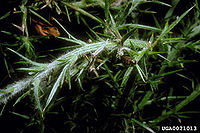
Agonopterix nervosa
Encyclopedia
The Gorse Tip Moth is a smallish moth
species
of the family
Oecophoridae
(concealer moths). Therein, it belongs to the subfamily Depressariinae
, which is (particularly in older sources) sometimes placed in the related family Elachistidae
instead, or elevated to a full family Depressariidae within the Gelechioidea
.
 It is found in Europe
It is found in Europe
and North America
. The wingspan
is 16–22 mm. Adults fly from July to September depending on the location.
The caterpillar
s feed on broom
s, namely of the genera
Cytisus
, Genista
, Laburnum
(golden chains) and Ulex (gorses).
Moth
A moth is an insect closely related to the butterfly, both being of the order Lepidoptera. Moths form the majority of this order; there are thought to be 150,000 to 250,000 different species of moth , with thousands of species yet to be described...
species
Species
In biology, a species is one of the basic units of biological classification and a taxonomic rank. A species is often defined as a group of organisms capable of interbreeding and producing fertile offspring. While in many cases this definition is adequate, more precise or differing measures are...
of the family
Family (biology)
In biological classification, family is* a taxonomic rank. Other well-known ranks are life, domain, kingdom, phylum, class, order, genus, and species, with family fitting between order and genus. As for the other well-known ranks, there is the option of an immediately lower rank, indicated by the...
Oecophoridae
Oecophoridae
Oecophoridae is a family of small moths in the superfamily Gelechioidea. The phylogeny and systematics of gelechoid moths are still not fully resolved, and the circumscription of the Oecophoridae is strongly affected by this....
(concealer moths). Therein, it belongs to the subfamily Depressariinae
Depressariinae
| image = Psorosticha zizyphi .jpg| image_width = 240px| image_caption = Adult Psorosticha zizyphi| regnum = Animalia| phylum = Arthropoda| classis = Insecta| ordo = Lepidoptera| subordo = Glossata| infraordo = Heteroneura...
, which is (particularly in older sources) sometimes placed in the related family Elachistidae
Elachistidae
| image = Elachista rufocinerea 2.jpg| image_width = 240px| image_caption = Adult Elachista rufocinerea,demonstrating its tiny size versus an aphid and a spider mite | regnum = Animalia| phylum = Arthropoda| classis = Insecta...
instead, or elevated to a full family Depressariidae within the Gelechioidea
Gelechioidea
| name = Curved-horn moths| image = Xylorycta assimilis.jpg| image_width = 240px| image_caption = Adult Xylorycta assimilis of the Xyloryctidae, photographed in Aranda Note prominent "horns" and long antennae| regnum = Animalia| phylum = Arthropoda...
.

Europe
Europe is, by convention, one of the world's seven continents. Comprising the westernmost peninsula of Eurasia, Europe is generally 'divided' from Asia to its east by the watershed divides of the Ural and Caucasus Mountains, the Ural River, the Caspian and Black Seas, and the waterways connecting...
and North America
North America
North America is a continent wholly within the Northern Hemisphere and almost wholly within the Western Hemisphere. It is also considered a northern subcontinent of the Americas...
. The wingspan
Wingspan
The wingspan of an airplane or a bird, is the distance from one wingtip to the other wingtip. For example, the Boeing 777 has a wingspan of about ; and a Wandering Albatross caught in 1965 had a wingspan of , the official record for a living bird.The term wingspan, more technically extent, is...
is 16–22 mm. Adults fly from July to September depending on the location.
The caterpillar
Caterpillar
Caterpillars are the larval form of members of the order Lepidoptera . They are mostly herbivorous in food habit, although some species are insectivorous. Caterpillars are voracious feeders and many of them are considered to be pests in agriculture...
s feed on broom
Broom (shrub)
Brooms are a group of evergreen, semi-evergreen, and deciduous shrubs in the subfamily Faboideae of the legume family Fabaceae, mainly in the three genera Chamaecytisus, Cytisus and Genista, but also in many other small genera . All genera in this group are from the tribe Genisteae...
s, namely of the genera
Genera
Genera is a commercial operating system and development environment for Lisp machines developed by Symbolics. It is essentially a fork of an earlier operating system originating on the MIT AI Lab's Lisp machines which Symbolics had used in common with LMI and Texas Instruments...
Cytisus
Cytisus
Cytisus is a genus of flowering plants in the legume family, Fabaceae. It belongs to the subfamily Faboideae.-Selected species:* Cytisus arboreus DC.* Cytisus ardoini E.Fourn.* Cytisus baeticus Steud....
, Genista
Genista
Genista is a genus of legumes which includes many species of broom. Many of these brooms are notorious as noxious weeds.Species include:*Genista aetnensis - Mount Etna broom*Genista anglica - petty whin, needle furze*Genista canariensis...
, Laburnum
Laburnum
Laburnum is a genus of two species of small trees in the subfamily Faboideae of the pea family Fabaceae, Laburnum anagyroides and L. alpinum . They are native to the mountains of southern Europe from France to the Balkan Peninsula...
(golden chains) and Ulex (gorses).
Synonyms
Obsolete scientific names of the Gorse Tip Moth are:- Agonopterix blackmori Busck, 1922
- Agonopterix boicella (Freyer, 1835)
- Agonopterix costosa (Haworth, 1811)
- Agonopterix depunctella (Hübner, [1810-1813])
- Agonopterix dryadoxena (Meyrick, 1920)
- Agonopterix venosata (Kautz, 1930)
- Depressaria nervosa Haworth, 1811

